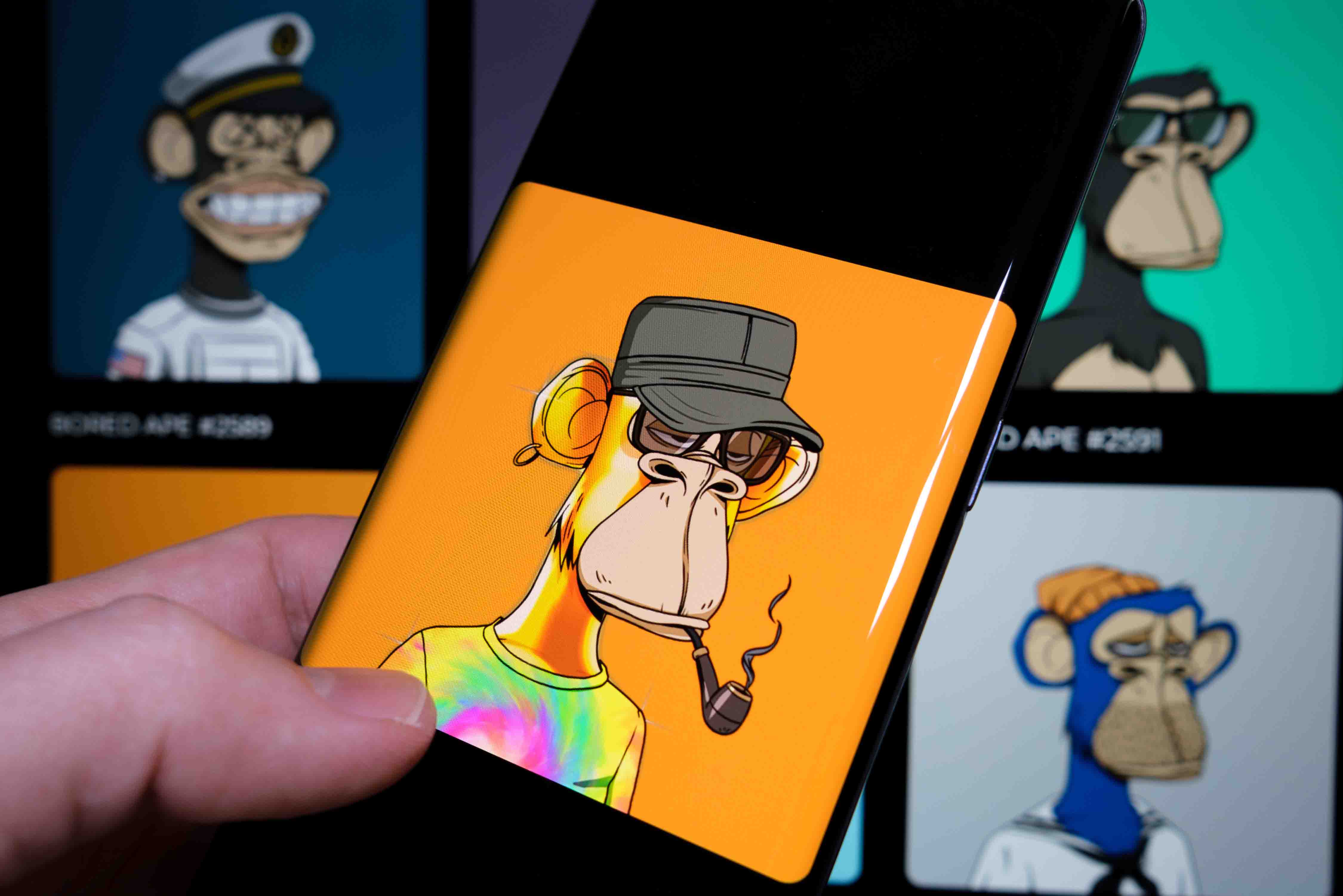Too big to ignore? Why attitudes over NFTs in media are changing

From big media players to wartime leaders, non-fungible tokens continue to become a hot option for creating new income streams in changing industries. But with the gold rush comes risks that brands and media owners need to take into account while exploring the new and burgeoning world of NFTs.
It was widely reported this month that Spotify became the latest major media player seeking to add blockchain technology and non-fungible tokens to its audio streaming service.
The music streaming company recently posted job openings for “Web3” related projects – the concept of a new iteration of the World Wide Web which will be based around blockchain technology with elements of decentralisation and token-based economics.
NFTs use blockchain technology, such as Ethereum, to provide proof of ownership of digital assets such as artwork, games, and memes.
Critics of NFTs and cryptocurrency have warned that they are speculative bubbles, with investors taking on risk in volatile assets that have cooled off a bit recently.
But with risk comes potential for reward, explains Evan Gettinger, executive strategy director at WPP’s global brand and design business Superunion.
“At a basic level, NFTs are a new vehicle for content delivery that is dynamic and changeable over time. It’s very early days in terms of extracting the potential value hidden here.”
Simon Pont, CEO of BLiX, a permission-based CRM platform, adds: “NFTs represent a potential that’s too big to ignore. That’s why Spotify, YouTube, Twitter, et al are trialling and making hires in this space.”
The recent hiring moves by Spotify have drawn speculation that they are looking to follow other tech companies in their foray into NFTs.
“Fear of being sucker-punched into riding the hype train prompts understandable pause and reluctance, whether you’re a brand, media owner, agency or independent creator,” Pont notes.
A new frontier in engagement?
The caution seems to be abating, though, as Big Tech companies have hinted at plans for integration of NFTs into their offerings.
At SXSW this month, Mark Zuckerberg announced that Facebook and Instagram would look to fuse NFTs into Facebook and Instagram in the next few months, though it is unclear how exactly Meta wants to incorporate NFTs into its platforms.
YouTube similarly announced in February that it would be incorporating Web3 technology in its new creator tools, allowing creators to “collaborate on new projects and make money in ways not previously possible.”
For example, YouTubers could sell fans unique videos, photos, art, and other user experiences as NFTs.
Reddit has also been exploring the world of NFTs with a dedicated page for selling CryptoSnoos, their own digital collectibles, and TechCrunch reported in January that the site is testing other ways to incorporate NFTs into their user experience, such as for avatars.
Twitter, meanwhile, already allows for Twitter Blue users to showcase NFTs as profile pictures, giving them a unique hexagonal shape, and Jack Dorsey made headlines last year for auctioning off the very first Tweet as an NFT for $2.9m (£2.1m), which he donated to charity.
gm!
You asked (a lot), so we made it. Now rolling out in Labs: NFT Profile Pictures on iOS pic.twitter.com/HFyspS4cQW
— Twitter Blue (@TwitterBlue) January 20, 2022
Twitter Blue is Twitter’s new subscription service – launched in June of last year, it offers extra bells and whistles to paying subscribers such as the ability to undo Tweets and a “Reader Mode”.
Ashley Cooksley, North American managing director of social media ad agency The Social Element, explains that social media brands, in particular, have good reason to be entering the NFT market.
“We haven’t even begun to experience the full potential of NFTs yet,” Cooksley tells The Media Leader. “We’re eagerly watching the space as it applies to social media specifically. Because of the nature of what an NFT is and where it lives—in the virtual realm—the integrations into the social media space are quite exciting.
“Think of it this way: NFTs are a way for consumers to engage with brands. Social media is a vehicle for that engagement, creating avenues for brands to interact with consumers everywhere they want to be.”
And within the music industry, NFTs could be used to sell a limited number of digital albums and merchandise, providing musical artists with income in an industry that has increasingly made it difficult for artists to make money from streaming services and record labels.
Spotify is likely seeking to tap into this very same market, with music collectors being the key target for exclusive NFT products.
Notable musicians such as Grimes, Kings of Leon, and 3LAU have already sold music as NFT tokens, while other artists such as Snoop Dogg and Eminem have drawn attention for collecting NFTs.

Bored Ape Yacht Club (above) has become one of the most popular NFT collections. Rapper Eminem made headlines for ‘joining the club’ when he purchased a digital ape artwork for $452,000 in January.
Pont notes that NFTs can be many things—an asset class, a revenue raiser, an early-access motivator—and warns that as such, old school principles need apply for media companies exploring the space.
He warns: “Understand your motivations for trialling. Be clear on your objectives. Know your audience. Make sure you can test and learn.”
Creating even bigger star power in virtual worlds
Snoop and Eminem joined other notable rappers at this year’s Super Bowl halftime show in Los Angeles, though their performance was unrelated to the NFL also announcing in March that it would grant teams permission to seek blockchain partnerships.
While teams will continue to be prohibited from directly promoting cryptocurrency, the league will allow blockchain advertisements to play during its games next season.
It’s perhaps unsurprising that sports leagues, with their intense focus on player personalities and star power, have sought to wade into the world of NFTs.
The NFL and other leagues have partnered with collectibles company Panini, who have begun making NFTs, to produce NFT trading cards of players. The NFL and players union also struck a deal with blockchain company Dapper Labs to produce video collectibles.
Announced this morning on the Official Panini Discord. We will have @UFC NFTs debut in the NFT/Physical program Mosaic Blockchain on 1/24. If you are not familiar with these come join the Discord and have all your questions answered.#panininfthttps://t.co/jeRWApdeVQ pic.twitter.com/azQgPrbc2N
— Panini America (@PaniniAmerica) January 21, 2022
But Gettinger explains that there could be a lot more to NFTs for brands than just selling keepsakes.
“Most brands (and consumers) treat NFTs as collectible investments today. That’s certainly a valid way of looking at them, but often ends up having more value to the consumer than the brand.
“NFTs have the ability to facilitate continuous engagement between a brand and its consumers, and more than that provide access to exclusive experiences on an ongoing basis. Both of these are key levers for turning consumers into fans and driving relationships from transaction toward affinity.”
Pont agrees: “Brands have always looked to create ‘communities of interest’ and groups of advocates and loyalists. NFTs can allow a brand to reward consumers for their advocacy, drawing them emotionally closer.”
In the world of (non-American) football, Crypto.com was announced as a sponsor for the 2022 FIFA World Cup in Qatar, and 17 of England’s 20 Premier League clubs have at least one sponsorship with a company in the cryptocurrency sector, including Watford and Southampton who rep cryptocurrencies as the main sponsor on their shirts.
Meanwhile, superstar Lionel Messi was announced as Socios.com’s global brand ambassador this week in a $20m deal with the fan token company. Socios.com had just recently inked a different sponsorship deal with UEFA in February.
The NBA has been similarly aggressive in their ventures into the crypto market – the league landed its first crypto sponsorship with Coinbase in October, a $192m deal over four years.
A slew of teams have cut additional deals: last Christmas, the Lakers’ and Clippers’ stadium was renamed to the much-bemoaned Crypto.com Arena; in June the Miami Heat’s arena was similarly named the FTX Arena after the crypto platform which also agreed to an international rights sponsorship with the Golden State Warriors. Meanwhile, the Portland Trailblazers added StormX jersey patches beginning in 2021, promoting the crypto cashback company.
As mentioned, not all NFT endeavors are being well received – a particular lowlight was NBA rookie Jalen Green promoting a video NFT by wearing it on a chain at this year’s dunk contest … and then botching his dunk attempt.
Josh Christopher just handed Jalen Green an NFT of his own dunk highlight to wear as a chain. pic.twitter.com/10zkG0far2
— Salman Ali (@SalmanAliNBA) February 20, 2022
Backlash is always a risk, and the aggression with which leagues have suddenly promoted NFTs and cryptocurrency has some fans feeling overwhelmed. Even the San Antonio Spurs selling 1,336 NFTs to charity in honour of coach Gregg Popovich’s win record was poorly received by some fans on Reddit.
Not to mention rightful concern about scams; NBA player De’Aaron Fox was heavily criticised in February for ditching his NFT project after raking in $1.5m.
Regardless, it’s clear that big crypto and NFT companies have been pouring resources into inking sponsorship deals in the world of sports, be it with teams or individual athletes.
Evan Gettinger explained the symbiotic potential for brands such as those in sports: “I do think the barrier to entry is lower for brands that have cultivated a sub-culture of superfans with rituals, symbols, and values that NFTs can strategically tap into to further fuel fandom.”
Greater diversity in political fundraising
Political advertising in the US is a massive business – Kantar predicts total spending to reach $7.8bn for the 2022 midterms, with a large and growing portion of ad spending devoted to digital media.
In that context, it becomes clear why NFTs have become an increasingly attractive way to obtain additional campaign revenue, especially as political campaigns are, in a way, an experiment in effective branding and marketing.
Democrat Shrina Kurani, who is running for a House seat in California, and Republican Blake Masters who is vying for a Senate position in Arizona, have both dangled NFTs as incentives to donors, with mixed results.
Masters, for example, sold an NFT version of his book, co-written by entrepreneur and fellow conservative Peter Thiel, as part of a campaign solicitation, charging $5,800 for it and other perks, and raising $550k, according to his own site. Due in part to the demand, Masters is now releasing an additional 20,000 NFTs in May or June based on original artwork from the book.
 Picture: Gage Skidmore/The Star News Network
Picture: Gage Skidmore/The Star News Network
Thiel co-founded PayPal and Palantir Technologies, was a major influence on Facebook as its first outside investor, and has been known to invest in conservative causes, such as right-wing YouTube alternative Rumble.
Kurani, meanwhile, incorporated NFTs into her campaign messaging, launching 230 NFTs through the marketplace Abris to signify the 230 billion tons of carbon remaining in the world’s “carbon budget”.
Abris is built on Algorand, which partnered with ClimateTrade to purportedly provide carbon negative blockchain technology.
NFTs are bought and sold on blockchain marketplaces that use cryptocurrencies to maintain secure financial records of transactions, and it is worth noting that the environmental cost of cryptocurrency is staggeringly high.
The amount of energy needed to ‘mine’ for bitcoin (the process by which individuals solve complicated puzzles in order to create the currency as reward) is intentionally inefficient, and as such, Bitcoin and Ethereum together now consume more energy per year than entire developed countries, such as Italy.
In response, Greenpeace and other environmental advocacy groups yesterday launched a new campaign, titled “Change the code, not the climate”, in an effort to stop Bitcoin from polluting the planet.
For companies attempting to meet ESG pledges, NFTs and cryptocurrency present a clear and significant environmental and PR risk.
“There are things a brand must consider about NFTs including their environmental impact—this is something we’re keeping an eye on since it could impact brands negatively,” said Cooksley.
But, as Pont notes and as Kurani has attempted, with the right approach NFTs can potentially stand for something more positive.
“NFTs can serve as a vehicle for a brand endorsing and galvanising audiences around a shared endeavour. […] So the idealist in me hopes that NFTs will become about brands stepping up, having a bigger, more noble role in people’s lives, where they can leverage their profile and following, and where altruism can also be commercially self-serving.”
Meanwhile on the (far) Right, the Trumps have also sought to capitalise on the rise in popularity of NFTs – Melania Trump launched the “POTUS TRUMP” NFT Collection in February, consisting of digital artwork of moments from former president’s administration.
And the National Republican Congressional Committee announced last June that they would begin accepting cryptocurrency campaign contributions.
“The NRCC is proud to lead the charge in accepting cryptocurrency campaign contributions. […] This innovative technology with help provide Republicans the resources we need to succeed,” said NRCC Chairman Tom Emmer in a statement.
The US Federal Election Commission approved the use of cryptocurrency for campaign donations without a legal limit on contributions in 2014.
However, reporting crypto donations is complex, and campaigns and committees must convert the assets to dollars – incurring a processing fee in the process – in order to actually spend the money.
For its part, the Biden administration released an executive order on cryptocurrencies in March, the first time the White House has sought to weigh in on the topic.
The order recognised the rise in popularity of non-state issued digital assets, which have climbed from a total market cap of $14bn in November 2016 to $3tn in November 2021, and directed the US Department of the Treasury, Federal Reserve, and other federal agencies to study and plan policy going forward, including the potential development of a US Central Bank-certified digital dollar.
Amid war, Ukraine sees opportunity in a digital revolution
But it’s not just political campaigns in America that want in on NFTs – the government of Ukraine is also selling a set of 54 NFTs covering the first three days of Russia’s invasion into Ukraine in February.
The collection, titled “Meta History: Museum of War”, was announced by Ukraine’s Minister of Digital Transformation Mykhailo Fedorov.
“While Russia uses tanks to destroy Ukraine, we rely on revolutionary blockchain tech”, he wrote on Twitter.
While Russia uses tanks to destroy Ukraine, we rely on revolutionary blockchain tech. @Meta_History_UA NFT-Museum is launched. The place to keep the memory of war. And the place to celebrate the Ukrainian identity and freedom. Check here: https://t.co/IrNV0w54tg
— Mykhailo Fedorov (@FedorovMykhailo) March 25, 2022
Friends of Ukraine can purchase tokens that include a news item about substantial events in the ongoing war, with proceeds going toward the Ministry of Digital Transformation to support the army and civilians of Ukraine.
Cryptocurrency has played a large role in both sides of the conflict, highlighting potential uses for digital sources of alternative income during war.
Though critics have highlighted that cryptocurrency could allow Russians to avoid the crippling economic sanctions imposed by western allies, Ukraine has also capitalised on crypto to raise nearly $100m, keeping the economy afloat despite the national bank being effectively inoperable amid the invasion. Cryptocurrency has thus proved to be an unlikely stabilizing force of financial security for millions of displaced Ukrainians who need quick access to fiat currency.
The development begs the question of how crypto and NFTs may be used in the future of warfare, as tools for both financial aid and perhaps even propaganda to help maintain or boost morale domestically and curry favour abroad.
To repeat Gettinger: “The barrier to entry is lower for brands that have cultivated a sub-culture of superfans with rituals, symbols, and values that NFTs can strategically tap into to further fuel fandom.”
That applies to governments too.
Jack Benjamin is US reporter for The Media Leader. Having recently rebranded, we will be formally launching in the US very soon…



